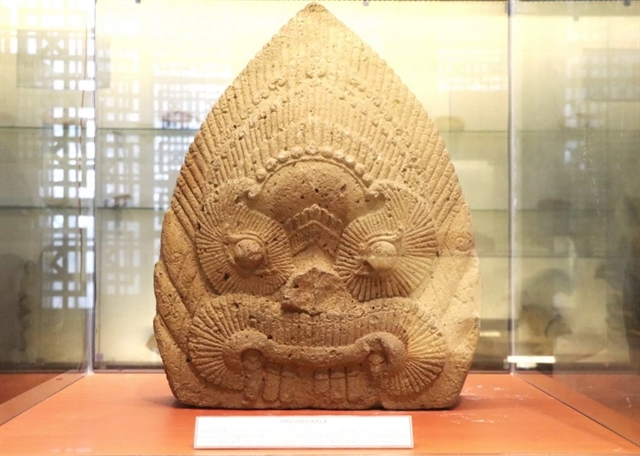Research indicates that this artefact is in the late Tháp Mẫm sculptural style and is the latest known Kala head from this artistic tradition. This is also the last complete Kala head, with only a minor defect on the nose.

The Kala bas-relief was discovered at the Núi Bà excavation site in Mỹ Thạnh Đông Hamlet, Hòa Phong Commune, Tây Hòa District, and was transferred to the provincial museum in 1993. — VNA/VNS Photo Tường Quân
PHÚ YÊN — The Kala bas-relief of Núi Bà in the central coastal province of Phú Yên has been recognised as a national treasure.
The Kala sculpture was discovered at the Núi Bà excavation site in Mỹ Thạnh Đông Hamlet, Hòa Phong Commune, Tây Hòa District, and was transferred to the provincial museum in 1993.
The artefact, carved from Rhyolitic Dacitic rock, measures 60cm in height, 44cm in width, is 17cm in thick and weighs 105.5 kg.
Research indicates that this artefact is in the late Tháp Mẫm sculptural style and is the latest known Kala head from this artistic tradition. It is also currently the last complete Kala head, with only a minor defect on the nose.
No other Kala heads dating beyond the 14th century have been found to date.
Many other artefacts were also found within the cultural layer of the site, along with the foundation of a Chăm temple architecture. This serves as scientific evidence to confirm that the Kala piece of Núi Bà is an original artefact.
This uniqueness enhances its value as a one-of-a-kind, symbolising the Chăm sculptural art style.
The Kala bas-relief of Núi Bà is currently being exhibited at the Phú Yên Museum.
In Chăm sculpture, Kala represents Shiva, the Hindu deity of destruction and cosmic renewal. Kala is a Hindu guardian deity, often sculpted over temple entrances as a guardian. The common characteristics of a Kala face typically include two horns, bulging eyes, small ears, full cheeks and jagged teeth with two prominent fangs. Notably, the Kala face lacks a lower jaw and chin.
The Kala bas-relief of Núi Bà is Phú Yên's first national treasure, officially recognised by the Government of Việt Nam. This recognition holds great significance for the preservation and promotion of the province's cultural heritage, particularly Chăm heritage.
Phú Yên’s provincial leaders have instructed the Department of Culture, Sports, and Tourism to effectively manage, preserve and promote the value of this national treasure. Additionally, they have encouraged further research to identify and document other artefacts that meet the criteria for national treasure recognition.
The Director of the Phú Yên Museum, Nguyễn Hữu An, said that the museum will organise a special exhibition on the Chăm cultural heritage in Phú Yên and will also digitise artefacts and publish materials introducing the museum’s collection, including the Kala piece. — VNS